The Euphorbia trigona, or more commonly known as the African Milk Tree (and sometimes a candelabra cactus or cathedral cactus) is the perfect aesthetic house plant to add to your collection.
African Milk Tree care is relatively easy, and one of the best low maintenance large houseplants. The right pot, enough bright light and watering only when the soil is dry are the basics of keeping this plant happy and healthy.
While it might look like it, the Euphorbia trigona is not actually cactus – it’s a succulent.

It can grow very fast, especially in spring and summer months.
Many people who enjoy the African Milk Tree as an indoor plant report these plants growing up to be 6 to 8 feet tall. In perfect conditions, some plants will shoot up a foot with several arms each growing season.
They tend to go dormant in the winter season, with almost no new growth. During this time, you will find the plant color usually becomes a deeper green.
One of my favorite things about being a plant parent is watching them transform through the seasons.
This plant doesn’t come without warning, though.
The African Milk Tree produces a poisonous sap when punctured – which makes it an unpopular choice or pet owners or those with young children. It can be very poisonous to cats and dogs if ingested, so it’s best to keep this plant out of reach.
As long as there’s no milky substance dripping out, you’re ok. Just don’t let it get onto your skin (and definitely not in your eyes).
Many people mix up the Euphorbia trigona with Euphorbia lactea.
To spot the difference – the trigona species branches grow close to the main body and tend to be slim. Whereas the lactea is generally a little stockier looking and its arms are more prone to branch out wider and further from the center.

This post contains affiliate links, which means I may make a small commission if you click through and make a purchase.
Watering Needs
Since it’s a succulent, the African Milk Tree can handle a little more water than your typical cactus. Still, allow it to dry between waterings and watch for signs of overwatering.
You can either use your finger or something like a chopstick to test how dry the soil is.
In the summer season, you can expect to have to water your Euphorbia about once every 7-10 days, but it could probably go up to 2 weeks without water and not notice!
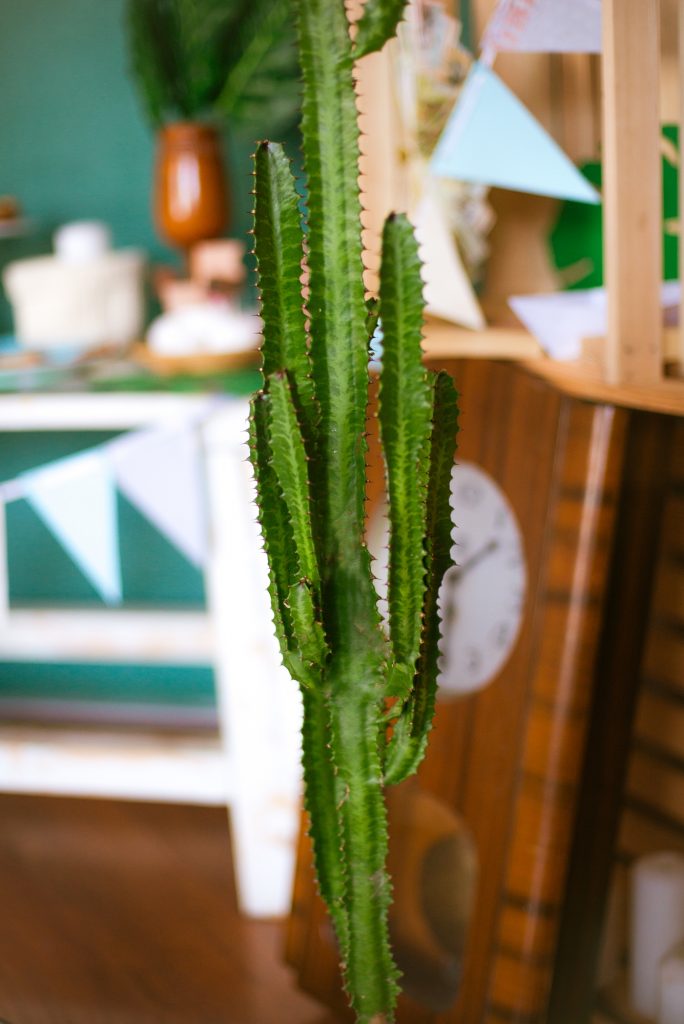
If you want to be extra precautious, you could add a moisture meter to the soil.
In the wintertime, it will need much less water. Likely not more than once per month, maybe even less.
When do you water your cactus-wannabe, give it a good soak until water seeps out the bottom into the saucer below.
However, don’t dump the water out right away. Allow the water to stay in the bottom for a few minutes to allow the bottom roots to soak up anything extra they need.
Then, either dump the water or use a towel to soak it up.
Place it in a terracotta or unglazed clay pot for added help with pulling away excess moisture.
Read more here about choosing the best type of pot for your succulent.
Bright Light
Your African Milk Cactus will thrive in lots of sunlight. Ideally, several hours of slightly filtered but bright light would be perfect.
It will do well in a bright, sunny room. But it’s important to acclimate it first, as they are prone to sunburn if introduced to long periods of hot sunlight.

Propagation and Pruning Your African Milk Tree
African Milk Trees are one of the easiest plants to propagate – the stem cuttings do very well. Plus, these plants can handle regular pruning to help it grow more uniform and upright.
The most important part of pruning an African Milk Tree is to wear protection – thick gloves and safety glasses or goggles.
This plant contains a toxic sap or milky substance that is highly irritating to the skin and can cause severe itching and pain. It’s very important to not come in contact with the sap.
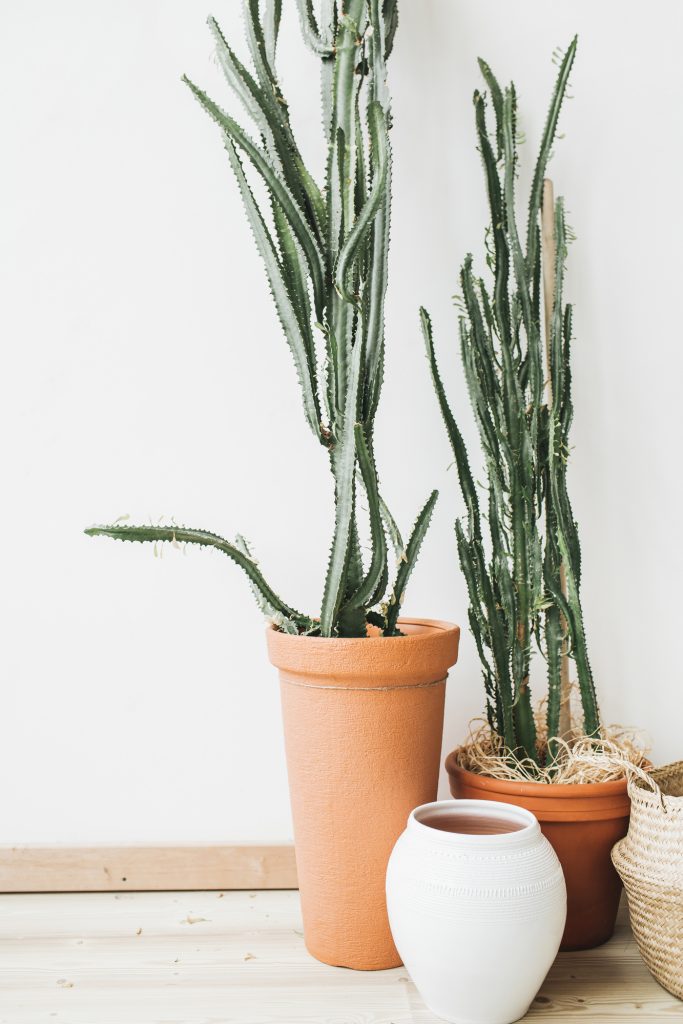
To propagate, choose a branch that’s about 3 to 6 inches long. Sterilize a sharp razor blade with isopropyl alcohol to make the cut.
Run the cutting under cold water to stop the sap from dripping – do the same with the mother plant, or dab it with a paper towel.
Place the cutting on a paper towel or a terracotta or clay saucer to let it dry out for a few days. Let it sit in a bright spot, but not in direct sun.
You want the cut end to dry out and callous over. Once this has happened, plant it in some soil (the same pot if you want) and pack it down just enough so it stays upright.
Wait about a week before you water the new cutting. This will allow it to form roots and stabilize itself.
You will be able to tell when it’s ready for water when you give it a gentle poke with a stick or a spoon and if it feels like there’s some resistance, you can go ahead and give it a little water.
To get your new African Milk Tree cutting to grow faster, you can use a rooting hormone on the cut end to help kick start its growth.
However, I find that these are mostly gel based and don’t work as well for succulents and cacti that need drier environments.
I’ve had better luck using Super Thrive once the cutting is planted and you’re ready to water it. You can usually find this at your local hardware store.
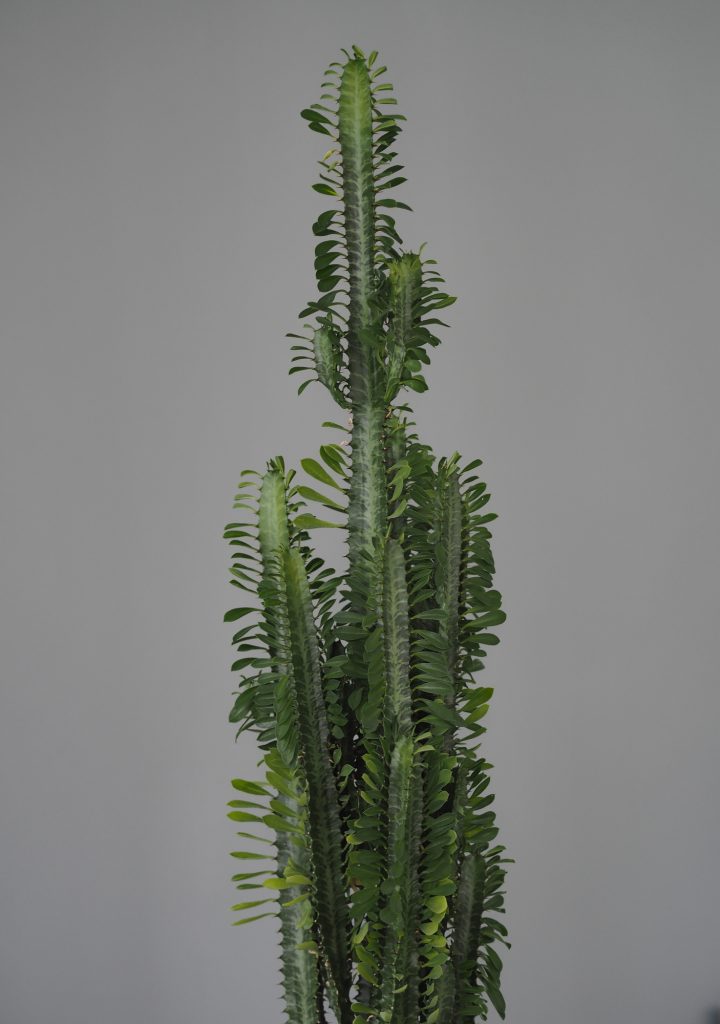
Common Problems with the African Milk Tree and How to Fix Them
If you’re wondering whether your African Milk Tree is dying, it might just be as simple as identifying a few symptoms, correcting them and then it should spring back to life.
They’re quite hardy indoor plants compared to others you might have in your home.
Yellowing Leaves
One of the most common problems with the Euphorbia is yellowing leaves. Most likely this is a sign of overwatering.
To correct it, try to place it in a sunnier spot to allow it to dry out and then only water it once the soil is dry all the way through.
If you’ve recently repotted your Euphorbia or have brought it in from living outside, the leaves may also turn yellow just from a little shock and getting used to its new home.
Sunburn
Dark yellow, orange, red or brown tips could indicate sunburn on your African Milk Tree. While they need plenty of light to survive, they don’t like to get too hot or be exposed to direct sun.
If you notice signs of sunburn, your plant isn’t dying, but you should move it to a spot with a little less direct sun.
It’s also good practice to rotate your plant about a quarter turn each time you water it to ensure it gets an even amount of light.
Pests to Watch Out For
As with many houseplants, the Euphorbia can be susceptible to pests such as mealybugs, scale bugs and spider mites.
Thankfully, most bugs are easy enough to get rid of and won’t cause your plant to die as long as the infestation isn’t major.
Read more about several ways to get rid of mealybugs and other pests on your cactus and succulent plants.
Falling Over
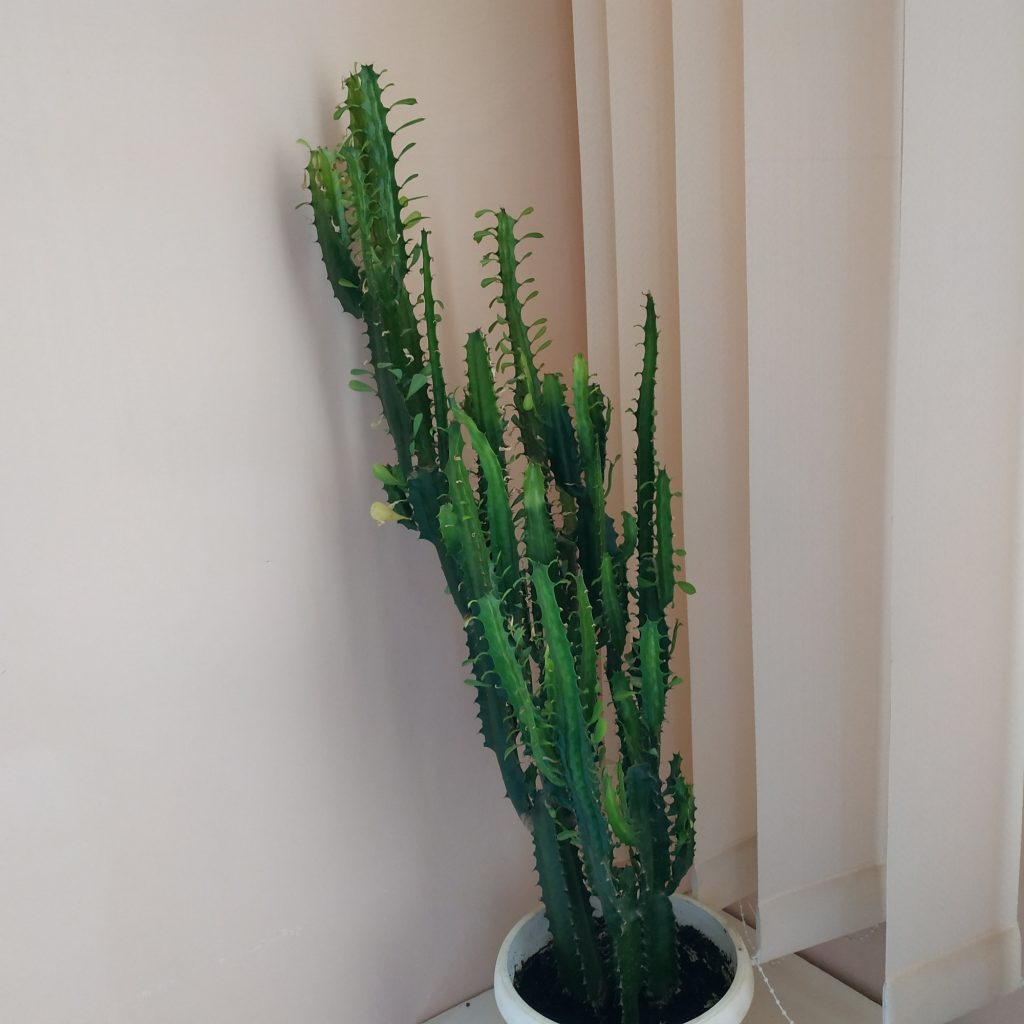
A common occurrence among the Euphorbia cactus is that they grow so fast that they start to fall over from being top heavy.
Since their root system is generally quite small and non invasive, the plant has less stability than it looks like it would have.
This can be prevented by regularly pruning the tree and adding stakes for added support to keep it upright.
Plus, a heavy clay pot will help with added weight at the base to help keep it in place.
If you have a Euphorbia sitting next to a railing (or something similar), you can also loosely secure it with some garden velcro tape to help support it.
If it does end up falling over, some stems may snap. This is ok! Just sterilize a razor blade and clean up the parts that snapped.
Let the orphan branch dry out for a few days and then just plant it back in the soil of the same pot (provided there’s room).
Many people who want to keep them tall without falling over will cut off the arms or off-shoots of each stalk to prevent added weight and encourage upward growth.
Final Tips on Caring for Your African Milk Tree
What’s so unique about this beloved houseplant is that it produces small leaves on each ridge of the arms of new growth – almost like delicate little petals.
The leaves are actually produced in between 2 thorns that grow along the edges of the plant.
This foliage is short lived though, so don’t panic if they start to turn yellow, dry up and fall off. This is part of the natural life cycle of the African Milk Tree.
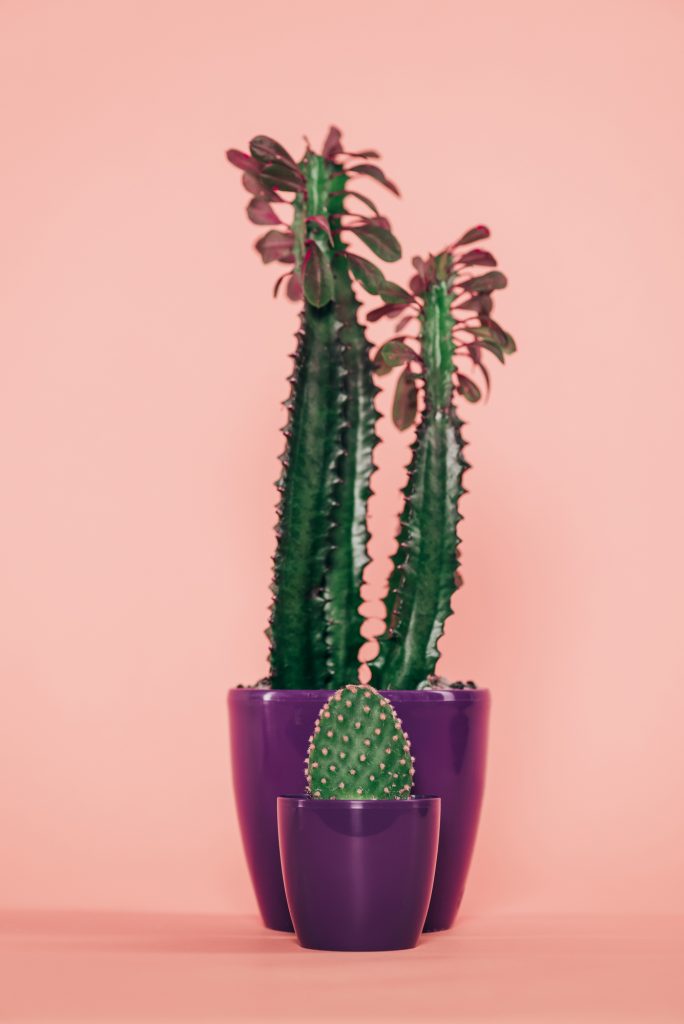
Also, if your plant is looking happy and healthy but turning a light purple-reddish color, you likely have the euphorbia trigona ‘rubra’ variety which produces the color from the more sun it gets.
If you’re noticing that the base of the stems are brown, this is likely corking and is a natural part of a cactus becoming mature.
Take a closer look – if the brown stem appears to be woody and fibrous (not dark brown or mushy), this is called corking and the plant is strengthening its base to support itself.
Once you have a Euphorbia trigona, follow these tips and you can expect to enjoy this plant for decades!
Stay Green!


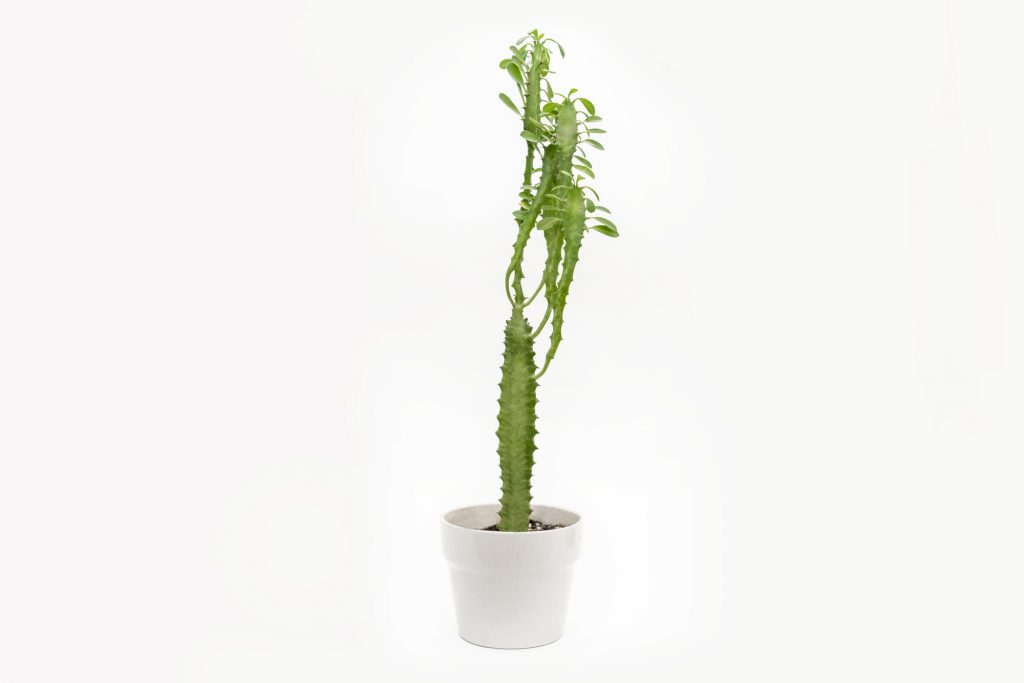
Hi, I’m in desperate need of some help figuring out what’s going on with my partners euphorbia. He has had it for about 6 years and I dont want it to die on him now. The plant overall still has a bunch of new growth and looks healthy, but the base is turning yellow and we can’t figure out if it is over watered or under watered or maybe it got sunburned? I don’t see a place to attach photos
Hi Audrey, us it yellow or is it corking? It sounds like a mature plant and if it’s been producing new growth over the last several months, hopefully this is just corking. This happens as the plant matures at the base in an effort to strengthen itself to support its growth. If it looks like the green is turning yellow, this could be the start of rot. I would stop watering for a while. Also, has it been in the same pot for 6 years? If so it’s likely due for a re-pot with fresh soil. And that’s when you can check the base & roots for rot.
Hi Aly, my plant has grown out of control and done a face-plant. It’s in a place I normally only go to over summer. I’ve cut off all of the branches that have hit the ground. The majority of them are a brown colour on the side that faces the main stem. Is this just aesthetics? I have about 10 offcuts, some with pups, and a few almost 1m. I was thinking about selling some because there’s no way mum will let me keep that many. lol
Hi, my African Milk Tree is about 12 feet high and some of the branches/stocks are starting to fall over, it has many branches , can I just cut back all the branches from 12 feet to 8 feet?
Hi Sandy, I would suggest cutting back the long branches that have fallen over too much, and then stabilizing the remaining branches of the plant instead of just cutting the tops off.
Yes but wear gloves as that milky sapp is highly poisonous to pets (cats/dogs) and it causes severe itching in humans if it’s contacting to your skin. Please be careful and safe
The woody base of my milk plant tree is very crooked… any ideas on how to remedy this?